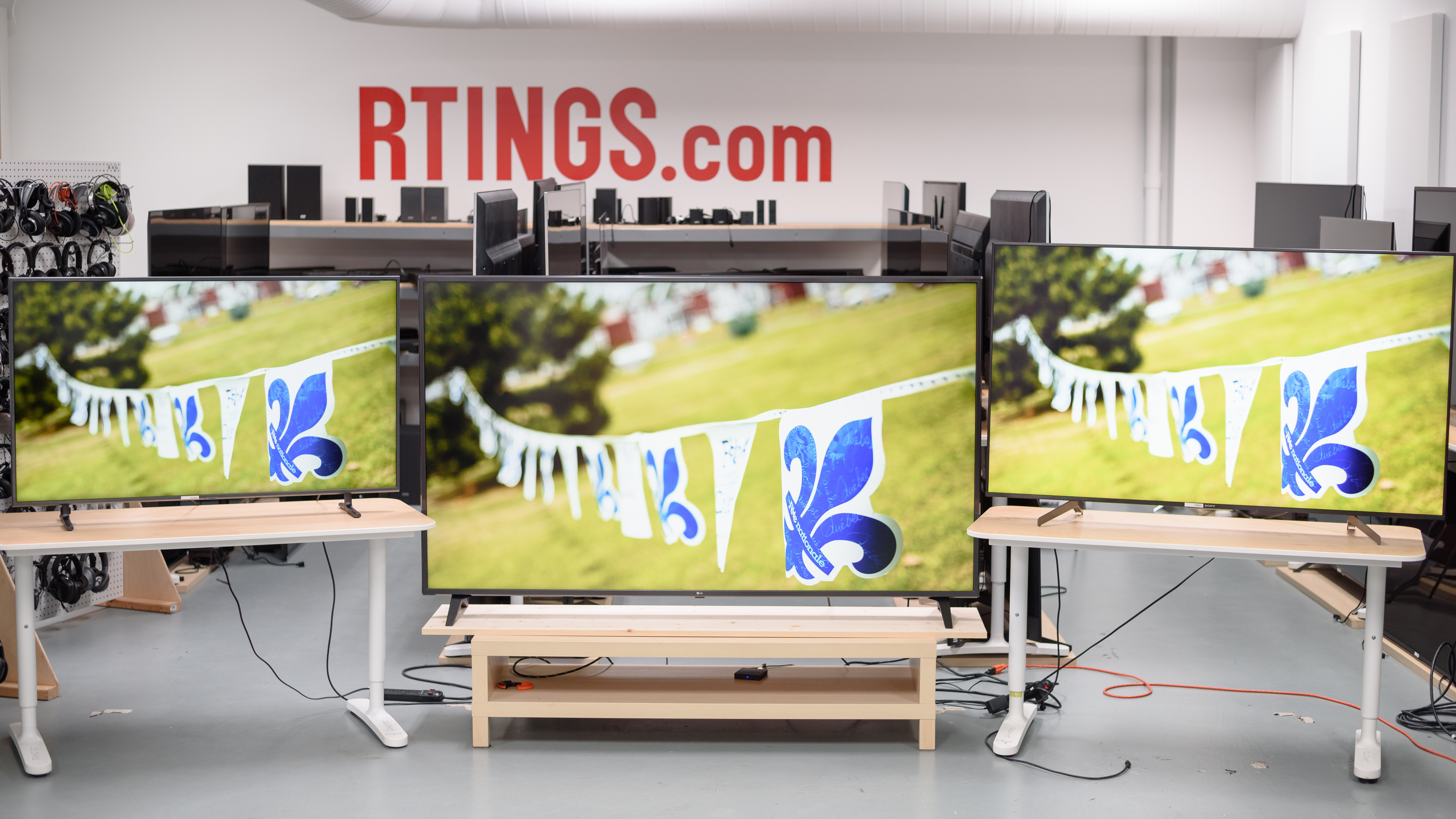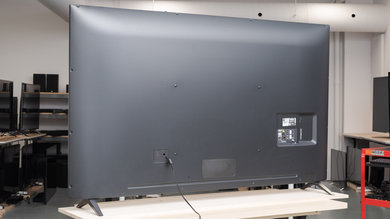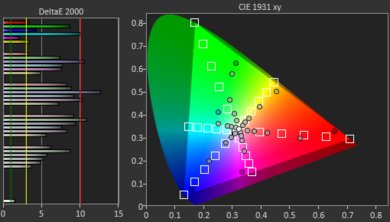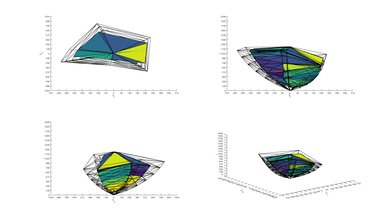The 86" model (86UM8070PUA) has an IPS panel, so we expect it to have wider viewing angles at the expense of a worse dark room performance.
Our Verdict
This is a good TV for mixed usage. It can handle reflections well, but it's more suitable for an average-lit room as it can't get very bright. It has an extremely fast response time that delivers crisp motion and a very low input lag that makes it very responsive. Unfortunately, it doesn't have a wide color gamut, so HDR isn't that great. Finally, it's only available in two variants. The 82" one has a VA panel and better dark room performance, and the 86" one has an IPS panel and we expect wider viewing angles at the expense of lower contrast ratio.
- Very low input lag.
- Extremely fast response time delivers crisp motion.
- HDR doesn't add much.
- No local dimming to improve dark room performance.
This is a decent TV for watching movies. The 82" model has a great contrast ratio and very good black uniformity and thus can deliver deep blacks which enhance picture quality. We expect the 86" model with the IPS panel to have worse dark room performance. and thus a lower score in the 'Movies' category. Neither model supports local dimming to improve blacks. This TV has decent gray uniformity, can interpolate motion up to 120 fps for the soap opera effect fans, and can remove 24p judder from any source.
This is a good TV for watching TV shows. It can handle reflections well and, although it can't get very bright, you should have no issues placing it in a room with a few light sources. It upscales content well from cable boxes or native apps, and has decent gray uniformity. Unfortunately, the 82" model with the VA panel has poor viewing angles and the image degrades when you watch from the side. If you enjoy watching TV shows while doing chores, then consider the 86" model since the IPS panel will allow you to experience better picture quality when you aren't sitting straight in front.
This is a decent TV for watching sports. It can handle reflections well, although it's more suitable for a not-too-bright room. It has an excellent response time so fast-moving content like sports looks crisp with minimal blur. Unfortunately, the decent gray uniformity might disappoint some hockey fans, as the rink might display with some darker spots. The 82" model isn't great if you plan to watch a game with friends as the viewing angles are poor. If this is something that concerns you, then the 86" model might be a better choice since it has an IPS panel with better viewing angles.
This is an excellent TV for playing video games. It has a very low input lag and the TV reacts immediately to your actions. Fast-moving video games look crisp thanks to the extremely fast response time, and upscaling from older consoles is good without any issues. Unfortunately, the TV doesn't support any of the advanced gaming features, but it does offer an auto low latency option.
This is a decent TV for watching HDR movies. It has a great contrast ratio and good black uniformity that improves blacks in a dark room where HDR is meant to be watched. Unfortunately, it can't get very bright in HDR and doesn't have a wide color gamut, so it can't deliver HDR content the way its creator intended. We expect that the 86" model will have an even worse contrast ratio and worse black uniformity, so 'HDR Movies' performance should be worse for this model.
Playing HDR games on this TV is great. This is due mainly to the very low input lag and the extremely fast response time. It doesn't have a wide color gamut, can't get very bright in HDR, and can't display HDR content as it should be. Furthermore, we expect the 86" model to have worse performance in HDR due to the IPS panel that can't deliver a high contrast ratio.
This is a very good TV for use as a PC monitor. It has a low input lag, is very responsive, and the image is crisp thanks to the fast response time. It can display proper chroma 4:4:4, so text looks clear, and it has no risk for permanent burn-in if you show static images like OS menus. If you are considering using it as a PC monitor for presentations, the 86" model might be a better choice since it has an IPS panel and offers wider viewing angles at the expense of a lower contrast ratio.
Changelog
- Updated May 21, 2020: Converted to Test Bench 1.5.
- Updated Feb 21, 2020: Converted to Test Bench 1.4.
- Updated Aug 12, 2019: Review published.
- Updated Aug 10, 2019: Early access published.
Check Price
Differences Between Sizes And Variants
We tested the 82" LG UM8070 (82UM8070). For the most part, we expect our review to be valid for the 86" model (86UM8070PUA).
There is, however, a significant difference between these two models. The one we tested has a VA panel, whereas the 86" has an IPS panel. We expect that, just like most IPS panels, the 86" model will have wider viewing angles at the expense of a lower contrast ratio and consequently a worse dark room performance.
| Size | US | Canada | UK | Panel Type |
| 75" | 75UM8070PUA | 75UM8070PUA | N/A | IPS |
| 82" | 82UM8070PUA | 82UM8070PUA | N/A | VA |
| 86" | 86UM8070PUA | 86UM8070AUB | N/A | IPS |
Update 09/24/2019: LG has released a 75" version, which, like the 86" version, has an IPS panel.
If someone comes across a different type of panel or if their LG UM8070 doesn't correspond to our review, let us know and we will update the review.
The 82UM8070 we reviewed was manufactured in June 2019.
Popular TV Comparisons

The LG UM8070 is a good TV for most uses. See our recommendations for the best TVs, the best smart TVs, and the best 4k TVs.
The Samsung RU8000 is a bit better than the LG UM8070. The Samsung can get brighter, so it's more suitable for a brighter room and has better gray uniformity, which should please sports fans. Also, the Samsung has an optional BFI feature that can make motion look crisper, and it supports FreeSync VRR for nearly tear-free gameplay.
The Samsung Q60R is somewhat better than the LG UM8070. The Samsung can get much brighter, so it can fight the glare of a brighter room, but it can't handle reflections as well as the LG can. The Q60R has much deeper blacks thanks to the higher contrast ratio and supports BFI to make motion look crisper. The Q60R is loaded with gaming features like FreeSync support and low input lag with motion interpolation, sure to please gamers.
The LG UM8070 and the Sony X850G have different panels, each with its advantages and disadvantages. The LG delivers deeper blacks in a dark room thanks to its higher contrast ratio and better black uniformity due to its VA panel. The Sony has an IPS panel and the image remains accurate for wider viewing angles. The Sony has better gray uniformity, which will please sports fans, and it's more suitable for a brighter room as it can get brighter and can handle reflections better. The UM8070, on the other hand, has a faster response time and delivers crisper motion in fast-moving content.
The LG UM8070 and the LG UK6570 have different panels, each with advantages and disadvantages. The UM8070 has a VA panel that delivers better dark room performance thanks to its higher contrast ratio and better black uniformity. The UK6570 has an IPS panel with wider viewing angles and favors watching TV from the side. The UK6570 can handle reflections better, but the response time on the UM8070 is faster and thus motion looks crisper on the UM8070. The LG UM8070 has an IPS panel and the differences with the UK6570 should be less apparent in that respect.

We buy and test dozens of TVs yearly, taking an objective, data-driven approach to deliver results you can trust. Our testing process is complex, with hundreds of individual tests that take over a week to complete. Most of our tests are done with specially designed test patterns that mimic real content, but we also use the same sources you have at home to ensure our results match the real-world experience. We use two main tools for our testing: a Colorimetry Research CR-100 colorimeter and a CR-250 spectroradiometer.
Test Results

This TV is part of LG's 2019 basic lineup. It's only available in large sizes (82UM8070PUA and 86UM8070PUA), and its main competitors are expected to be the larger-sized models like the Sony X850G or the Samsung RU8000.
The overall design of the LG UM8070 is decent. It has a simple stand that supports the TV well but can't prevent all wobble. The TV has a metal back that looks very plain, and the borders of the screen are slightly thick but aren't annoying. It's a little thicker than most TVs, but given its size it's hard to notice. The TV is heavy, but has a solid build that should give you no issues.
The back of the TV is very plain and made of metal. The power cable can't be removed. Also, some of the connectors are facing outwards and can get in the way if you plan to wall-mount it flush to the wall. There is no provision for cable management.
The contrast ratio of this TV is great, although not as good as other VA panel TVs like the recently reviewed Hisense H8F. Nonetheless, blacks look good in a dark room, even though there is no local dimming feature to further improve their appearance.
We expect the 86" version of this TV (the 86UM8070) to have a worse contrast ratio due to its IPS panel.
Unfortunately, this TV doesn't have a local dimming feature. The above video is for reference only.
The UM8070 has decent SDR peak brightness, which is okay for most decently-lit rooms. It's not as bright as the UM7300, but more closely resembles last year's UK7700. Like many LG TVs, there is very little variation in brightness with different content, and this is great.
We measured the peak brightness after calibration with the 'ISF Expert (Dark Room)' Picture Mode, Gamma set to '2.2' and Color Temperature set to 'Warm 2', as these settings are the most accurate. Different picture modes and color temperatures can produce slightly different results.
If image accuracy isn't as important to you, the 'Vivid' Picture Mode delivers a slightly brighter image, reaching a peak of 366 cd/m² with a 10% window.
This TV has disappointing HDR peak brightness and can't show off small bright highlights in some scenes. It's worse than the UM7300 and last year's UK7700.
We measured the HDR peak brightness with the 'HDR Cinema' Picture Mode and Color Temperature set to 'Warm 2' before calibration. Different picture modes and color temperatures can produce slightly different results.
If image accuracy isn't as important to you, the 'Vivid HDR' Picture Mode can produce a slightly brighter image with a peak of about 363 cd/m² with a 10% window.
The viewing angles of this TV are poor, as expected from a VA panel. Blacks rise quickly and gamma and colors shift at relatively small angles off-center, making the image look inaccurate and washed out.
The 86UM8070PUA has an IPS panel, and we expect it to have better viewing angles at the expense of worse dark room performance. Although IPS panel TVs usually have better viewing angles than VA panel TVs, they still can't reach the viewing angle performance of OLEDs like the LG C9. If viewing angles are a concern and you can afford the extra cost, make sure you check out our Best OLED TV recommendations.
Good pre-calibration color accuracy for the UM8070. Some inaccuracies are visible in the grays and colors, but nothing major. The color temperature is slightly warm and the gamma doesn't follow the target very well. This results in some bright scenes appearing slightly over-brightened, whereas some really dark scenes appear even darker.
After calibration, the UM8070 has excellent accuracy as most of the inaccuracies disappear and those remaining are hard to spot. The gamma follows the target well, and the color temperature is spot on the 6500K target.
You can see our recommended settings here.
The LG UM8070PUA has a decent color gamut, but lacks a wide color gamut. The 'Expert (Dark Room)' EOTF (above) follows the target PQ curve well (although some dark scenes do appear slightly crushed) until it rolls off near the TV's peak brightness. The Game mode EOTF is almost identical.
If you find HDR too dim, setting Dynamic Tone Mapping to 'On' and Dynamic Contrast to 'High' increases the brightness of bright scenes, and helps reduce the crush in the very dark scenes. See our full recommendations here.
Mediocre color volume on this TV. Unfortunately, it can't produce very bright colors. These results are better than UK6300 and the UM7300, but these TVs have IPS panels and can't deliver saturated dark colors due to their low contrast ratio. This might also be the case with the 86UM8070PUA, which has an IPS panel, but we can't be sure as we haven't tested it.
Excellent gradient performance overall, but on our test pattern, there is some noticeable banding in almost all areas. In normal content, this is not as obvious. If banding bothers you, the Smooth Gradation feature can remove banding in normal content, but can also cause a loss of some fine details in some scenes.
There is a very faint temporary image retention that you can see in our test image. However, this is not noticeable in normal content and just like the LG C9, our software doesn't detect it.
We don't expect VA panels to experience permanent image retention, as the VA panel in our long-term test appears immune.
The UM8070 has a remarkable response time. The transition from one image to the next is almost instantaneous and without overshoot. This leads to very crisp motion with minimal blur. This measurement is among the best of the LED TVs we've tested and is at par with the Vizio P Series Quantum X 2019.
The UM8070 uses PWM flicker to dim the backlight. The flicker frequency is 120Hz and the flicker is always on, even at maximum Backlight. This causes noticeable duplications, as seen in our Motion Blur photo.
The LG UM8070PUA doesn't have a Black Frame Insertion feature. The backlight flicker at 120Hz helps clear up motion, but causes some noticeable duplications in motion, as seen in our Motion Blur photo.
The UM8070 has excellent motion interpolation features. It can interpolate content up to 120 fps if you set both the 'De-Judder' and the 'De-Blur' sliders to max. However, just like many TVs, when you interpolate fast action or low fps content to 120 fps you'll notice some distracting artifacts, so use caution.
To find out more about motion interpolation, and how to enable it on this TV, see here.
The UM8070 has a very fast response time. Since the transition from one movie frame to the next is extremely fast, each frame is held on the screen for a longer time and thus motion appears to stutter. This is more noticeable in wide-panning shots, and you can minimize it by enabling motion interpolation.
The UM8070 can remove judder from any source as long as Real Cinema is set to 'On'. However, at 60i signals (like some cable boxes), you have to take the extra step of enabling Trumotion and setting both sliders to '0', as also explained here
The LG UM8070 has a 120Hz refresh rate, but it doesn't support any of the variable refresh rate technologies, like FreeSync or HDMI-Forum's VRR.
The LG UM8070 has a remarkably low input lag. Even though it's not as low as the UK7700 or the UK6300, it's very low and makes the TV a great choice for gaming. The input lag will remain low at almost any supported input signal, as long as 'Game' mode is enabled. Just like this year's UM7300, this TV supports auto low latency mode, as long as Instant Game Response is enabled for the HDMI port in use.
See our recommended gaming settings here.
The LG UM8070 supports all of the common 60Hz input resolutions and most of the 120Hz resolutions except for 4k @ 120Hz, which requires higher bandwidth than the available HDMI ports can provide. It can display most of them (except 1080p @ 120Hz) with proper 4:4:4 chroma, so that text looks clear, as long as the input icon is changed to 'PC' from the Home Dashboard, and the HDMI ULTRA HD Deep Color setting is enabled for the port in use. The HDMI ULTRA HD Deep Color must be enabled if you wish to use the full HDMI bandwidth, which is necessary for some resolutions like 4k @ 60Hz + HDR.
It doesn't have HDMI 2.1 support, but the predecessor to it, the LG UN8500, does.
The UM8070 can pass through both DTS and Dolby Digital, which is great, but there is no support for eARC for higher quality audio formats.
The LG UM8070 has a disappointing frequency response. The low frequency extension (LFE) is at about 150Hz, which is among the worst we've measured so far. This results in a bass that can't produce any thump or rumble and almost has no body or punch. Above the LFE the frequency response is well-balanced, which results in clear dialog with a little less airiness. The TV is loud enough, provided that you're in a quiet environment, but it's not loud enough for places with a lot of ambient noise.
The distortion performance of the LG UM8070 is decent and quite close to the performance of the UM7300. The total amount of harmonic distortion is okay, but it increases at max volume.
LG's content store is one of the richest regarding the number of available apps. The most common ones are already pre-installed on the TV, but you can always add more and you can also cast from your smartphone or tablet.
The remote that comes along with the LG UM8070 is the same excellent one that is found on all LG high-end TVs. It allows some voice control of the TV and allows searching within some apps like YouTube and Netflix. It can be programmed to work with almost any external device regardless if it supports HDMI-CEC or not. Finally, it features the same pointer control system that many people find handy.
Just like the UM7300, there is only a single button on the UM8070. It's located in the center of the TV under the LG logo and allows changing the inputs, the channels, or the volume, and controls the power.














































